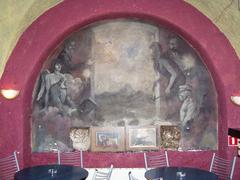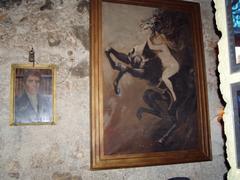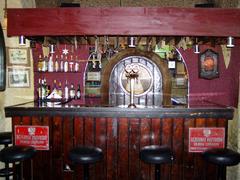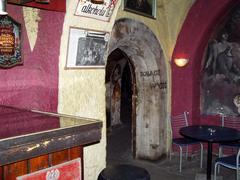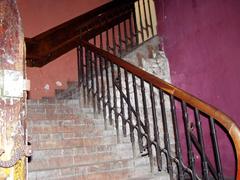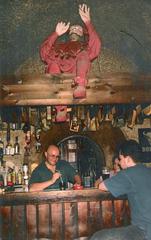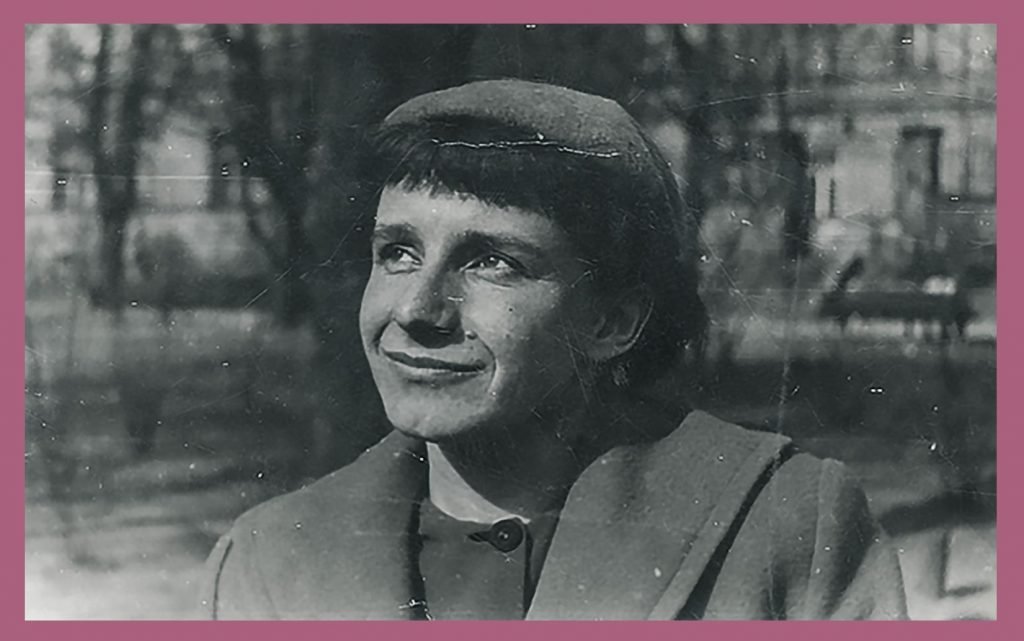
Piwnica Pod Baranami Kraków, Poland: Visiting Hours, Tickets, and Historical Significance
Date: 14/06/2025
Introduction
Piwnica Pod Baranami, located beneath the historic Pałac Pod Baranami on Kraków’s Main Market Square, stands as a legendary hub of Polish culture and artistic innovation. Founded in 1956 by Piotr Skrzynecki during a period of post-war cultural revival, the venue became synonymous with creative freedom, political satire, and avant-garde performance. Over the decades, it has not only shaped Kraków’s bohemian spirit but also played a pivotal role in Poland’s broader cultural and intellectual landscape (In Your Pocket; Wikipedia).
Today, Piwnica Pod Baranami remains a living testament to Kraków’s artistic heritage, inviting visitors to experience its unique blend of cabaret, jazz, and literary performance in a setting steeped in history. This guide will provide a comprehensive overview of the venue’s origins, cultural impact, visitor information—including current visiting hours and ticketing—and recommendations for exploring nearby historical attractions.
Table of Contents
- Introduction
- The Founding and Early Days (1956)
- The Literary Cabaret and Kraków’s Artistic Community
- Cultural and Political Significance Through the Decades
- Musical Innovation: Jazz at Piwnica Pod Baranami
- Piwnica Pod Baranami Today: Visiting Hours, Tickets & Practical Information
- Performance Experience and Venue Atmosphere
- Rituals, Traditions, and Festivals
- Tips for a Memorable Visit
- Frequently Asked Questions (FAQ)
- Suggested Itinerary
- Conclusion
- References
The Founding and Early Days (1956)
Piwnica Pod Baranami—translated as “Cellar Under the Rams”—was established in 1956 in the atmospheric cellars of Pałac Pod Baranami, a Renaissance palace renowned for its ram motifs. Created by Piotr Skrzynecki and a group of Kraków university students, the venue was conceived as a sanctuary for creative youth amid a climate of censorship and political repression (In Your Pocket).
Early performances blended literary cabaret, music, poetry, and improvisational theatre, attracting a vibrant artistic community and quickly earning a reputation for subversive wit and surreal humor (GoOut).
The Literary Cabaret and Kraków’s Artistic Community
From its inception, Piwnica Pod Baranami became a crucible for pioneering Polish artists, including Ewa Demarczyk, Joanna Olczakówna, Krzysztof Komeda, Marek Grechuta, and Krzysztof Penderecki. The venue’s literary cabaret performances wove together satire, poetry, music, and improvisation, providing a platform for both established and emerging talents.
This intellectual and artistic ferment attracted writers, musicians, filmmakers, and thinkers from across Poland, establishing Piwnica as a central institution in the city’s—and the nation’s—creative life (Culture.pl; GoOut).
Cultural and Political Significance Through the Decades
Throughout the 1960s and 1970s, Piwnica Pod Baranami was a focal point for cultural resistance. Its performances used allegory and surrealism to circumvent censorship, providing subtle yet incisive commentary on the realities of communist Poland. The venue became a meeting place for Kraków’s bohemian circles, a space for free expression, and a symbol of artistic defiance (In Your Pocket).
This tradition continues today, with performances reflecting both historical legacies and contemporary issues.
Musical Innovation: Jazz at Piwnica Pod Baranami
Piwnica Pod Baranami is also celebrated as a cradle of Polish jazz. From its earliest days, it hosted jazz luminaries such as Krzysztof Komeda, Tomasz Stańko, and Wanda Warska. In 1996, the venue helped launch the Summer Jazz Festival Kraków, now one of the world’s largest jazz events, with hundreds of concerts staged each year (GoOut).
The venue’s musical legacy continues to inspire new generations of artists and audiences alike.
Piwnica Pod Baranami Today: Visiting Hours, Tickets & Practical Information
Location
- Address: Rynek Główny 27, 31-010 Kraków, Poland
- Setting: Beneath the Pałac Pod Baranami, on Kraków’s Main Market Square
Visiting Hours
- Regular Performances: Saturdays at 21:00 (9:00 PM) for the main literary cabaret
- Jazz and Special Events: Days and times vary; consult official listings for the latest schedule
Tickets
- Price Range: 40–100 PLN depending on event and seating
- Purchase: Online via the official website, eBilet, or at the venue box office
- Reservation: Strongly recommended due to limited seating and popularity, especially around festivals
Accessibility
- The venue is located in historic cellars, accessible only by stairs; accessibility for those with mobility impairments is limited. Contact the venue in advance for individual needs.
Nearby Attractions
- Rynek Główny (Main Market Square): Europe’s largest medieval square, lined with historic buildings, cafes, and museums
- St. Mary’s Basilica: Iconic church with a stunning altarpiece and daily trumpet call
- Wawel Royal Castle: Symbol of Polish statehood and home to royal chambers, treasury, and cathedral
- Sukiennice (Cloth Hall): Renaissance trading hall with the Gallery of 19th-Century Polish Art
- Pałac Pod Baranami Cinema and Vis à Vis Pub: Art-house cinema and legendary artists’ meeting place nearby
(Karnet Krakow Culture; Krakow Travel)
Performance Experience and Venue Atmosphere
Stepping into Piwnica Pod Baranami is like entering a bohemian time capsule. The vaulted Gothic cellars, dim lighting, and eclectic décor set the scene for intimate performances filled with music, poetry, and satire. The audience, a mix of locals and international visitors, contributes to a lively, welcoming atmosphere.
During the Summer Jazz Festival and other special events, the venue becomes a hub for world-class musical innovation and spontaneous creative energy (KrakowTop.org).
Rituals, Traditions, and Festivals
Piwnica Pod Baranami is known for its unique traditions, including the annual Christmas opłatek (wafer-sharing) and Easter jajeczko (egg celebration), as well as elaborate anniversary balls held in historic locations. These communal rituals blend theatricality, music, and feasting, reinforcing the venue’s sense of artistic community (Culture.pl).
Tips for a Memorable Visit
- Arrive Early: Doors typically open 30–60 minutes before showtime; early arrival ensures better seating
- Language: Most performances are in Polish, but the music and ambiance are universally appealing
- Dress Code: Smart casual fits the relaxed, bohemian character
- Dining: Light snacks and drinks are served at the venue; for full meals, explore the many restaurants in the Old Town
- Combine Your Visit: Pair with visits to nearby attractions like St. Mary’s Basilica or the Rynek Underground Museum for a full cultural day
Frequently Asked Questions (FAQ)
Q: How do I buy tickets?
A: Purchase tickets online (eBilet), via the venue’s website, or at the box office.
Q: What are the visiting hours?
A: Performances generally start at 21:00 on Saturdays; jazz and other events vary—check event listings.
Q: Is Piwnica Pod Baranami wheelchair accessible?
A: Accessibility is limited due to stairs and historic architecture; contact the venue for assistance.
Q: Are performances in English?
A: Most are in Polish, but non-Polish speakers can enjoy the unique atmosphere and musical programs.
Suggested Itinerary
- Morning: Explore St. Mary’s Basilica and Sukiennice
- Afternoon: Visit Wawel Castle and stroll through Planty Park
- Evening: Attend a performance at Piwnica Pod Baranami, then unwind at Vis à Vis pub
Conclusion
Piwnica Pod Baranami is more than a cabaret or concert hall—it is an enduring symbol of Kraków’s artistic soul and Poland’s cultural resilience. Whether you are drawn by its storied history, live performances, or its pivotal role in the city’s creative life, a visit here is an essential part of experiencing Kraków. Plan ahead, secure your tickets, and immerse yourself in the unique spirit that has captivated generations.
For up-to-date schedules, ticket information, and event details, consult the official Piwnica Pod Baranami site, and consider using cultural apps like Audiala for additional resources.
References
- This article draws on information from (In Your Pocket), (Wikipedia), (Culture.pl), (Karnet Krakow Culture), (Krakow Travel), (GoOut), (KrakowTop.org), and (eBilet).

